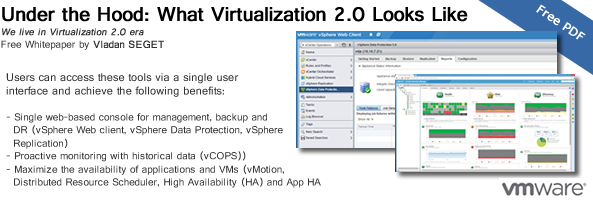I've been working for a project for VMware SMB recently. While I'm possibly good at promoting work of others or showing some tips for virtualization admins, it's quite hard to find some words to promote my work, to do a self-plug…
Today's admins challenges are to maintain the application performance, data security and availability. They want to prevent over or under utilization of their virtual infrastructure by knowing which part of the infrastructure isn't performing well or is exhausted. Whether it's storage, network, memory or CPU resources. Also they need to assure security of their datas or have some solid DR plan in case of disaster.
The application's users usually say, that the application performs slowly. Now the admin has to react and seek why.
- Is the storage the bottleneck?
- CPU resources of the VM, the CPU of the physical host?
- Or is it just the latest patch from Microsoft that has just made that critical Windows VM run very slow….?
VMware vSphere has all necessary tools built-in. vSphere Operations Manager is one of the top tools to provide end-to-end visibility. Followed by features like HA, vMotion, vSphere Replication or vSphere data protection.
The software products bundled with vSphere are tightly integrated into the vSphere suite providing single management console to the end user.

Quote:
Virtualization admins seek simplicity in this overcomplicated virtualization world, but at the same time they need to proactively gather and collect performance data, which they can use to identify root cause to improve the overall performance of their data centers. VMware vSphere with Operations Management has the necessary tools to keep businesses successful and competitive. It results in less manual interventions with automation capabilities and predictive analytics that help you avoid application failures and performance issues. Proactively monitoring capacity resources is a key factor to keep up with increasing storage demands and application load.
It was my first project for VMware and I did not really knew what to expect, but VMware team was very helpful. I hope that the results aren't too deceiving and that virtualization admins will get some tips and ideas while reading.
You can download the paper from this post at VMware website here. (Note that free registration is required for the download.)
You can also have a look at my WordPress page where I gathered some more technical whitepapers which might be your interest, or check out my free VMware tools page where you can find free tools to manage, monitor or backup virtual infrastructure running VMware vSphere or standalone ESXi hosts.
